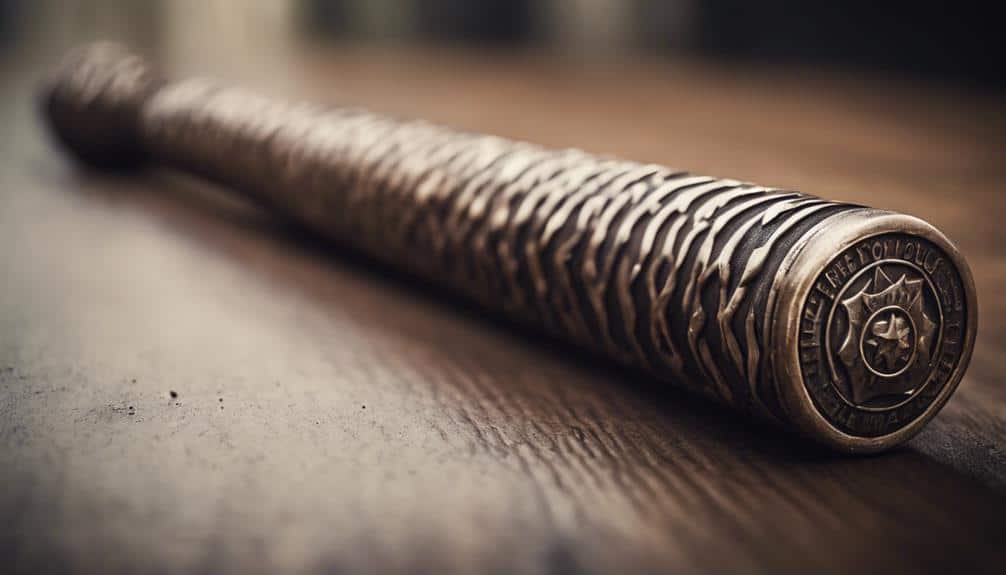So, you’re curious about the difference between a
baton and a
stun baton, huh? Well, imagine a baton as your classic,
tough, no-nonsense tool—perfect for whacking things with pure kinetic energy. It’s typically made of wood or metal and relies on your muscle power. Now, a stun baton? Oh, that’s a zappy,
high-voltage wonder, exuding 12 million volts to shock an attacker from a distance, sometimes with a handy flashlight. One’s a brute force brawler, the other’s a gadget-packed zapper, keeping
danger at arm’s length. Dive deeper, and you’ll uncover even more fascinating differences!
Traditional Baton Overview
A
traditional baton, often known as a police
baton or nightstick, is a
blunt-force weapon used primarily by
law enforcement for
striking and compliance.
Imagine this: you’re a police officer on the beat, and you’ve got this trusty baton by your side. It’s not just any stick; it’s usually made from
sturdy wood,
durable plastic, or even tough metal. These batons range from 16 to 26 inches long and can vary in weight and thickness, so there’s a perfect fit for everyone.
Now, the magic of a traditional baton lies in its simplicity. No electric shocks here—just good old-fashioned physical impact. You swing it with force and technique, aiming to control or incapacitate an assailant. The
kinetic energy from your swing does all the heavy lifting. You can also use it to apply pressure on certain points, making it a versatile tool in tricky situations.
But don’t forget, carrying and using a traditional baton isn’t as straightforward as grabbing one off the shelf.
Legal regulations can vary a lot depending on where you are. So, while it’s classified as less lethal, there are still strict laws about how and when you can use it.
Stun Baton Overview
Unlike the traditional baton, a
stun baton offers the added advantage of delivering a
high-voltage electric shock to incapacitate an assailant from a distance. Imagine wielding a tool that not only provides the
solid defense of a traditional baton but also packs the punch of at least 12 million volts. That’s a stun baton for you. With lengths ranging from 10 to 25 inches, these devices are
lightweight and easy to handle, making them super effective in self-defense scenarios.
Picture yourself in a dark alley, feeling a bit uneasy. A stun baton flashlight can light your way and
deter potential threats. The
built-in flashlight isn’t just for show; it’s a practical feature that enhances visibility, especially in low-light conditions. Plus, the mere sight of it can be intimidating enough to ward off troublemakers.
What’s more, these batons can deliver
multiple shocks without needing an immediate recharge, so you can count on them during prolonged altercations. Knowing that your stun baton can disrupt an attacker’s muscle function, causing
temporary paralysis, gives you a solid escape route. It’s like having an electrifying, multi-functional guardian right in your hand.
Mechanism of Action
When you activate a
stun baton, it sends a
high-voltage electric shock that disrupts an attacker’s muscle function, causing
temporary paralysis. This means that with just a press of a button, you can incapacitate someone threatening you, giving you precious moments to escape or call for help.
The stun baton works by delivering a
powerful electrical charge, typically around 12 million volts or more. When this charge hits the attacker, it messes with their
neuromuscular system, making their muscles go haywire. Imagine trying to move, but your muscles just won’t cooperate—that’s what happens to them.
Unlike a traditional baton, which relies on your physical force and needs you to get up close and personal, a stun baton lets you maintain a
safer distance. You don’t have to be a bodybuilder to use it effectively. Plus, it can deliver multiple shocks without needing a recharge, making it a reliable companion in dicey situations.
Physical Characteristics
Understanding how
stun batons work is essential, but equally important are their
physical characteristics that set them apart from traditional batons. Let’s explore!
A
standard baton, usually 16 to 26 inches long, is made from wood, plastic, or metal. It’s primarily built for
impact defense, so it’s straightforward and reliable. You swing it, and it gets the job done.
Now, a stun baton, that’s a whole different beast. Typically ranging from 10 to 25 inches, it combines the traditional baton with a
high-voltage stun gun. Imagine a baton on steroids, crafted from durable materials like aircraft-grade aluminum or high-grade steel. It’s not just about the whack; it packs an
electric punch, delivering 12 million volts or more to paralyze muscle function instantly.
These stun batons often come with cool add-ons like
built-in flashlights, making them perfect for visibility and intimidation. Traditional batons, meanwhile, don’t have any of these fancy electronic features.
And let’s talk weight—standard batons are generally lighter, while stun batons are heftier due to their
internal shock mechanisms. So, while a traditional baton is nimble, a stun baton feels more solid in your grip.
Usage Techniques
When you’re using a baton or a stun baton, getting a
good grip and stance is key, like holding a steering wheel before a wild ride.
Effective
striking techniques, whether you’re swinging a baton or pressing a stun baton against an attacker, can make all the difference in a sticky situation.
And hey, don’t forget about
safety and maintenance—keeping your gear in top shape is like making sure you’ve got a spare tire in the trunk, ready for anything.
Proper Grip and Stance
To effectively use a stun baton, grip its rubberized handle firmly with one hand to maintain control. This proper grip and stance are vital for your safety and effectiveness. Stand with your feet shoulder-width apart to create a stable base; this will help you stay balanced and move quickly if needed. Keep your knees slightly bent and lean a bit forward. This stance not only prepares you to react but also makes you look like you mean business.
Your non-dominant hand should rest near the top of the baton. Why? It gives you extra support and leverage, especially when you need to strike or stun. It’s like holding a baseball bat but with a shocking twist!
Practice moving between a defensive and offensive stance. This fluidity guarantees you’re ready for anything, whether you’re blocking an attack or delivering a powerful strike. Below is a quick reference table to sum it all up:
| Step |
Action |
| Grip |
Firmly hold the rubberized handle |
| Stance |
Feet shoulder-width apart, knees bent |
| Hand Placement |
Non-dominant hand near the top |
Master these steps, and you’ll handle your stun baton like a pro!
Effective Striking Techniques
Mastering
effective striking techniques with a stun baton requires
targeting key muscle groups to guarantee
maximum impact and incapacitation. It’s all about hitting those larger muscles. Envision you’re facing an attacker—aim for the thighs, shoulders, or abdomen. These areas not only absorb the shock better but also confirm your assailant is down for the count.
When you use stun batons, you want to
maintain distance. Use a
thrusting motion to keep your attacker at bay. Picture this: you’re extending your arm, baton in hand, pushing forward with a powerful strike. The long reach of the stun baton helps you stay safer while engaging.
Precision is key. Focus on
striking at a 45-degree angle. This enhances the shock’s effectiveness. Try quick jabs followed by a swift withdrawal. This creates space and keeps you from getting grabbed. Visualize a boxer’s jab—fast, sharp, and followed by a step back.
Rotate the baton in your grip to access different striking surfaces. This adaptability lets you respond to various threats efficiently. Remember, it’s about
control and precision, not brute force. So, practice these techniques, stay confident, and you’ll
handle any situation like a pro.
Safety and Maintenance Practices
After honing your striking techniques, let’s focus on keeping your stun baton in peak condition for reliable self-defense.
First, regularly inspect your stun baton for any signs of damage or wear. You don’t want to find out it’s broken when you need it most! Make sure it’s fully functional and safe to use in self-defense situations. Imagine the embarrassment of your stun gun failing at a critical moment!
Keep your stun baton charged and test it periodically in a safe environment. You’ve got to confirm it’s operational when you need it. Think of it like keeping your phone charged—no battery, no help.
Clean the rubber grip and metal surfaces with a non-abrasive cleaner. You don’t want a slippery grip in a tense moment, do you?
Store it in a secure,
accessible location. Quick deployment is key, but you also need to keep it out of kids’ reach.
Target Audience
So, who exactly are these batons for?
If you’re someone who’s into
self-defense, you might be wondering whether a regular baton or a
stun baton suits you better.
Self-defense enthusiasts, security personnel, and even some adventurous folks all have specific needs, and understanding these can help you pick the right tool for staying safe.
Target Audience
Whether you’re a
law enforcement professional or a civilian seeking
self-defense tools, understanding the differences between a
baton and a stun baton is essential for choosing the right equipment.
A traditional baton, mainly an
impact weapon, is used for striking or blocking. It’s great for those who need a reliable, straightforward tool. On the other hand, a stun baton adds a
high-voltage stun feature, packing a punch with 12 million volts or more to disrupt muscle function.
Law enforcement officers often prefer traditional batons for their durability and simplicity. They can withstand heavy use and don’t need a power source. Plus, they’re effective for crowd control and defense in close quarters.
Civilians, however, might lean towards stun batons for
personal safety. The electric shock can incapacitate an attacker from a distance, giving you a vital advantage.
Stun batons usually come with extra features like rubber grips and built-in flashlights, making them versatile and user-friendly.
Just remember,
legal restrictions vary, so check your local laws before choosing one. Ultimately, your decision should align with your
specific needs and the level of threat you anticipate.
Self-defense Enthusiasts
For
self-defense enthusiasts, choosing between a baton and a
stun baton hinges on understanding their distinct functionalities and benefits. If you’re looking for a self-defense tool, a
standard baton is great for
physical defense through striking. It’s all about delivering that solid, blunt force to fend off an attacker.
But if you want something with a bit more flair, a stun baton might be your go-to.
Imagine holding a stun baton, with its sleek design and rubber grip that feels just right in your hand. This isn’t just any self-defense tool. It combines the impact power of a traditional baton with the ability to deliver
high-voltage shocks—anywhere from 1 million to over 40 million volts.
Picture yourself in a sticky situation, and with a simple push, you’ve got an extended reach of up to 25 inches, plus the added shock factor to
incapacitate an assailant from a distance. Talk about feeling empowered!
Legal Considerations
Understanding the
legal landscape is essential when considering the
ownership and use of batons and
stun batons. You might think carrying a baton for self-defense is straightforward, but the reality is a bit more complex.
Legal restrictions on batons vary widely. In some places, you can’t own one at all, while others might require a
special permit. It’s pretty much a legal minefield!
Now, let’s talk about stun batons. They’re usually seen as non-lethal, but don’t let that fool you into thinking they’re always legal. Local laws might have
age restrictions or specific guidelines on how you can use them. And if you’re thinking about carrying a
police baton, think again! Law enforcement officers generally have the green light, but civilians often face stricter rules.
Some places even categorize batons as lethal weapons, which can lead to serious legal trouble if you don’t have the right authorization. The bottom line? Always check your
local regulations before making a purchase. You don’t want to end up on the wrong side of the law just because you didn’t do your homework. Legal penalties aren’t worth the risk!
Safety Tips
When handling a
stun baton, always make sure it’s fully charged and practice using it in a safe spot, so you know exactly what to do if things get hairy.
Keep an eye on
local laws because you don’t want any legal surprises, and regularly check your baton for any damage to keep it in tip-top shape.
Aim for
big muscle groups to stop an attacker without causing too much harm.
Proper Handling Techniques
Make certain your
stun baton is always
fully charged to guarantee it works effectively when you need it most. You don’t want to be caught off guard.
Practice using the baton in a
safe environment, like your backyard or a quiet park, to get a feel for its operation, reach, and power. Think of it like learning to ride a bike; the more you practice, the more confident you’ll become.
When you deploy the stun baton, keep a
safe distance from any potential attacker. Its long reach is your best friend, allowing you to stay out of harm’s way while still defending yourself. Imagine it’s like holding a shield that keeps the danger at bay.
Get to know the different
flashlight modes on your stun baton. These modes aren’t just for looks; they can help you
identify threats and even intimidate attackers in the dark. Picture yourself as a superhero with a gadget that lights up danger zones.
Maintenance and Inspection
To keep your
stun baton in top shape, regularly inspect its
battery and physical condition. You don’t want to be caught off guard during a
self-defense situation with a low battery, so make sure it’s fully charged and functional. Trust me, a dead stun baton isn’t going to scare anyone.
After each use, take a moment to
wipe down your stun baton, especially the contact points. This simple maintenance step helps prevent corrosion or buildup that might mess with the electrical delivery. Plus, a clean baton just looks more intimidating, right?
Don’t forget to check for any
physical damage. Cracks, dents, or any other wear and tear can seriously affect its performance. It’s like trying to defend yourself with a cracked baseball bat—just not effective.
If your model has moving parts, like a retractable feature, make sure you
lubricate them according to the manufacturer’s instructions. Smooth operation is key when you need it most.
Legal Considerations
Understanding the
legal landscape is essential before
owning or using a baton or stun baton. Legal considerations can make a big difference in how you use these tools, and you don’t want to be caught off guard. Laws vary widely depending on where you are, so it’s vital to know your
local regulations.
Some areas allow you to own a baton or stun baton only if you have a
permit or follow specific guidelines. Stun batons, though often considered non-lethal, might be
classified as lethal or dangerous in certain places, affecting their legality. That means you can’t just assume you’re in the clear.
Pay close attention to where you can
carry these items.
Public spaces often have strict rules, and violating them can land you in serious trouble.
Misuse of a baton or stun baton can result in hefty fines or even imprisonment. So, it’s not just about having the right tool but also knowing how to use it legally.
Stay updated on any changes in laws regarding defensive weapons. Legislation can change, and you don’t want to find out the hard way that what was legal yesterday isn’t today. Keep informed to stay safe and out of trouble.
Popular Models
Diving into popular models, the JOLT Peacemaker Stun Gun Baton stands out with its 12 million volts and compact design, making it a great entry-level choice. Imagine holding this sleek device—small enough to fit in your bag but powerful enough to deliver a shocking punch.
But let’s not stop there; there are other remarkable stun guns worth mentioning.
- Streetwise Mini Barbarian Stun Gun Baton: With 9 million volts, this model is perfect for those who need something highly portable. It’s like carrying a mini warrior with you everywhere.
- Safety Tech Rechargeable Stun Gun Baton: This one packs a whopping 40 million volts. Thanks to its rubberized coating, you’ll have a secure grip, making it feel like an extension of your own hand.
Each of these stun guns offers unique features tailored to different needs. Whether it’s the portability of the Mini Barbarian or the sheer power of the Safety Tech model, there’s a stun baton out there for everyone.
Effectiveness Comparison
When comparing the effectiveness of
stun batons and
traditional batons, you’ll quickly see that each has its own set of strengths and weaknesses.
A stun baton, delivering around 12 million volts, can
incapacitate an attacker without close contact. You don’t have to be right up in their face. Just think about the advantage of
striking from a distance—no need to engage in a
physical struggle. It’s like having an invisible shield, zapping away threats without a sweat.
Traditional batons, on the other hand, require you to get up close and personal. You’ll need some
serious strength and technique to take someone down. It’s all about the impact, the swing, and the force you apply. Sure, it’s effective, but it demands more from you physically. Not everyone can handle that.
Stun batons can affect a wide range of individuals, regardless of their pain tolerance. A quick zap disrupts their
muscle function, making it hard for them to move. But, you’ve got to keep that contact for it to work its magic.
Traditional batons mightn’t be as effective against someone who’s physically tough, but they can cause
lasting harm depending on your swing.
Frequently Asked Questions
A stun baton won’t knock you out. Its electrical effects cause pain, muscle contractions, and disorientation but not unconsciousness. The device is designed for temporary incapacitation, relying on high-voltage shocks rather than physical force.
Are Stun Batons Good for Self-Defense?
Yes, stun batons are good for self-defense. They’re effective, lightweight, and easy to carry. However, always check legal considerations in your area to ascertain you’re using them lawfully and responsibly. Proper training is essential.
Which Is Better, a Stun Gun or a Taser?
When considering a Taser vs. Stun Gun, a Taser’s better for distance and multiple shocks, while a stun gun requires close contact but can be used continuously. Check local laws since regulations differ between the two.
What Does a Stun Baton Feel Like?
A stun baton feels like an intense electrical sensation, causing a severe burning and cramping sensation. You’ll experience involuntary muscle contractions and intense pain, but it’s brief and only lasts while contact is maintained.









One Response